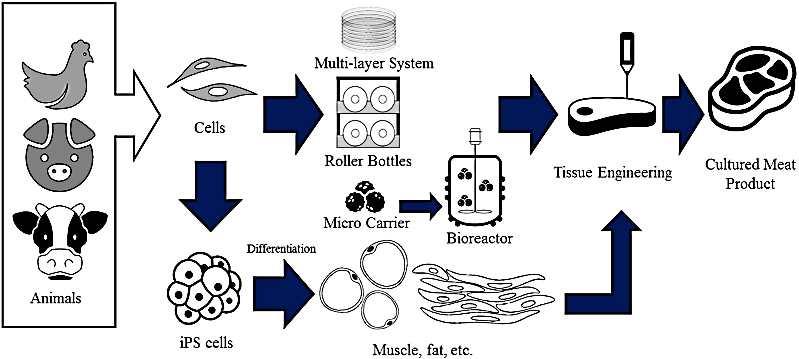To satisfy the increasing demand for food from the growing human population along with climate change, cultured meat (also called in vitro, artificial or lab-grown meat) can be a potential protein source for the world population. Meat substitutes are currently gaining attention as a way to overcome the shortage of meat supply against the growing global population and conserve the environment. The world population, which stands at 7.7 billion people in 2020, is expected to rise to 9.7 billion by 2050. This population growth is projected to increase the demand for meat 1.7 times from 2020 to 2050, and the demand is estimated to get double, particularly in developing countries where incomes are expected to improve. In terms of agricultural land use, as much as 77% of the total agricultural land is used for livestock breeding or feed cultivation. Producing meat substitutes, which requires the use of less land compared to livestock rearing, is expected to resolve concerns about the shortage of meat supply. There are two types of meat substitutes: plant-based meat and cultured meat. Cultivated meat is genuine animal meat (including seafood and organ meats) that is produced by cultivating animal cells directly in the laboratory. Cultivated meat is made of the same cell types arranged in the same or similar structure as animal tissues, thus replicating the sensory and nutritional profiles of conventional meat. On the other hand, plant-based meat is the cultured cells of protein rich plants like soybean that give a meat-like taste and texture to the consumer. Plant-based meat substitutes are already on the market, and their demand is rising every year in vegan communities.
Cultivating meat is similar to growing plants from cuttings in a greenhouse. This new method of meat production enables the natural process of cell growth. Cellular agriculture involves taking a small, harmless sample of cells from an animal and growing them in what is known as a cultivator. The cultivator facilitates the same biological process that happens inside an animal by providing the cells the warmth and the basic nutrients needed to transform into meat: water, proteins, carbohydrates, fats, vitamins and minerals. Embryonic stem cells are useful for cultivation because they multiply easily and can grow into any kind of cell. Cell collection typically involves a small muscle biopsy or skin scrape, both of which are harmless procedures that can be performed with local anesthesia. Although muscle, fat, and skin cells don’t multiply as easily as embryonic stem cells, these mature cells (adult stem cells) can be reprogrammed to behave similarly to embryonic stem cells.

Cell reprogramming can be accomplished by introducing a set of specific genes, proteins, or small molecules into the cells. Using cell reprogramming techniques improves the producers’ ability to use cells taken from a live animal and ultimately creates a more efficient and consistent production process. Researchers are also exploring the potential of these technologies to improve the nutritional profile of the meat. This production method eliminates the need to raise and farm animals for food. Although cultured meat is not yet commercially very available, research and development are underway to meet the demand for such as high value- beef. This increase in demand for meat substitutes can be considered from two points of view: response to meat supply shortage and environmental protection. Currently, companies like Nestlé (Switzerland), Kellogg’s (US), Tyson Foods (US), etc. are interested and started their business in it.
Tasnin Khan Eusufzai
Scientist, ASRBC



